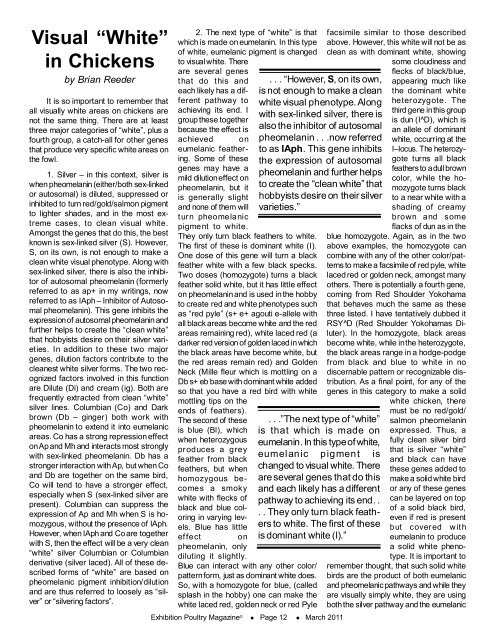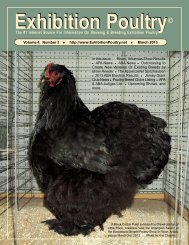Exhibition Poultry© Exhibition Poultry
Exhibition Poultry© Exhibition Poultry
Exhibition Poultry© Exhibition Poultry
You also want an ePaper? Increase the reach of your titles
YUMPU automatically turns print PDFs into web optimized ePapers that Google loves.
Visual “White”<br />
in Chickens<br />
It is so important to remember that<br />
all visually white areas on chickens are<br />
not the same thing. There are at least<br />
three major categories of “white”, plus a<br />
fourth group, a catch-all for other genes<br />
that produce very specific white areas on<br />
the fowl.<br />
1. Silver – in this context, silver is<br />
when pheomelanin (either/both sex-linked<br />
or autosomal) is diluted, suppressed or<br />
inhibited to turn red/gold/salmon pigment<br />
to lighter shades, and in the most extreme<br />
cases, to clean visual white.<br />
Amongst the genes that do this, the best<br />
known is sex-linked silver (S). However,<br />
S, on its own, is not enough to make a<br />
clean white visual phenotype. Along with<br />
sex-linked silver, there is also the inhibitor<br />
of autosomal pheomelanin (formerly<br />
referred to as ap+ in my writings, now<br />
referred to as IAph – Inhibitor of Autosomal<br />
pheomelanin). This gene inhibits the<br />
expression of autosomal pheomelanin and<br />
further helps to create the “clean white”<br />
that hobbyists desire on their silver varieties.<br />
In addition to these two major<br />
genes, dilution factors contribute to the<br />
cleanest white silver forms. The two recognized<br />
factors involved in this function<br />
are Dilute (Di) and cream (ig). Both are<br />
frequently extracted from clean “white”<br />
silver lines. Columbian (Co) and Dark<br />
brown (Db – ginger) both work with<br />
pheomelanin to extend it into eumelanic<br />
areas. Co has a strong repression effect<br />
on Ap and Mh and interacts most strongly<br />
with sex-linked pheomelanin. Db has a<br />
stronger interaction with Ap, but when Co<br />
and Db are together on the same bird,<br />
Co will tend to have a stronger effect,<br />
especially when S (sex-linked silver are<br />
present). Columbian can suppress the<br />
expression of Ap and Mh when S is homozygous,<br />
without the presence of IAph.<br />
However, when IAph and Co are together<br />
with S, then the effect will be a very clean<br />
“white” silver Columbian or Columbian<br />
derivative (silver laced). All of these described<br />
forms of “white” are based on<br />
pheomelanic pigment inhibition/dilution<br />
and are thus referred to loosely as “silver”<br />
or “silvering factors”.<br />
2. The next type of “white” is that<br />
which is made on eumelanin. In this type<br />
of white, eumelanic pigment is changed<br />
to visual white. There<br />
are several genes<br />
by Brian Reeder that do this and . . . “However, S, on its own,<br />
each likely has a different<br />
pathway to<br />
achieving its end. I<br />
group these together<br />
because the effect is<br />
achieved on<br />
eumelanic feathering.<br />
Some of these<br />
genes may have a<br />
mild dilution effect on<br />
pheomelanin, but it<br />
is generally slight<br />
and none of them will<br />
turn pheomelanic<br />
pigment to white.<br />
They only turn black feathers to white.<br />
The first of these is dominant white (I).<br />
One dose of this gene will turn a black<br />
feather white with a few black specks.<br />
Two doses (homozygote) turns a black<br />
feather solid white, but it has little effect<br />
on pheomelanin and is used in the hobby<br />
to create red and white phenotypes such<br />
as “red pyle” (s+ e+ agouti e-allele with<br />
all black areas become white and the red<br />
areas remaining red), white laced red (a<br />
darker red version of golden laced in which<br />
the black areas have become white, but<br />
the red areas remain red) and Golden<br />
Neck (Mille fleur which is mottling on a<br />
Db s+ eb base with dominant white added<br />
so that you have a red bird with white<br />
mottling tips on the<br />
ends of feathers).<br />
The second of these<br />
is blue (Bl), which<br />
when heterozygous<br />
produces a grey<br />
feather from black<br />
feathers, but when<br />
homozygous becomes<br />
a smoky<br />
white with flecks of<br />
black and blue coloring<br />
in varying levels.<br />
Blue has little<br />
effect on<br />
pheomelanin, only<br />
diluting it slightly.<br />
Blue can interact with any other color/<br />
pattern form, just as dominant white does.<br />
So, with a homozygote for blue, (called<br />
splash in the hobby) one can make the<br />
white laced red, golden neck or red Pyle<br />
is not enough to make a clean<br />
white visual phenotype. Along<br />
with sex-linked silver, there is<br />
also the inhibitor of autosomal<br />
pheomelanin . . .now referred<br />
to as IAph. This gene inhibits<br />
the expression of autosomal<br />
pheomelanin and further helps<br />
to create the “clean white” that<br />
hobbyists desire on their silver<br />
varieties.”<br />
. . .”The next type of “white”<br />
is that which is made on<br />
eumelanin. In this type of white,<br />
eumelanic pigment is<br />
changed to visual white. There<br />
are several genes that do this<br />
and each likely has a different<br />
pathway to achieving its end. .<br />
. . They only turn black feathers<br />
to white. The first of these<br />
is dominant white (I).”<br />
<strong>Exhibition</strong> <strong>Poultry</strong> Magazine © Page 12 March 2011<br />
facsimile similar to those described<br />
above. However, this white will not be as<br />
clean as with dominant white, showing<br />
some cloudiness and<br />
flecks of black/blue,<br />
appearing much like<br />
the dominant white<br />
heterozygote. The<br />
third gene in this group<br />
is dun (I^D), which is<br />
an allele of dominant<br />
white, occurring at the<br />
I–locus. The heterozygote<br />
turns all black<br />
feathers to a dull brown<br />
color, while the homozygote<br />
turns black<br />
to a near white with a<br />
shading of creamy<br />
brown and some<br />
flacks of dun as in the<br />
blue homozygote. Again, as in the two<br />
above examples, the homozygote can<br />
combine with any of the other color/patterns<br />
to make a facsimile of red pyle, white<br />
laced red or golden neck, amongst many<br />
others. There is potentially a fourth gene,<br />
coming from Red Shoulder Yokohama<br />
that behaves much the same as these<br />
three listed. I have tentatively dubbed it<br />
RSY^D (Red Shoulder Yokohamas Diluter).<br />
In the homozygote, black areas<br />
become white, while in the heterozygote,<br />
the black areas range in a hodge-podge<br />
from black and blue to white in no<br />
discernable pattern or recognizable distribution.<br />
As a final point, for any of the<br />
genes in this category to make a solid<br />
white chicken, there<br />
must be no red/gold/<br />
salmon pheomelanin<br />
expressed. Thus, a<br />
fully clean silver bird<br />
that is silver “white”<br />
and black can have<br />
these genes added to<br />
make a solid white bird<br />
or any of these genes<br />
can be layered on top<br />
of a solid black bird,<br />
even if red is present<br />
but covered w ith<br />
eumelanin to produce<br />
a solid white phenotype.<br />
It is important to<br />
remember thought, that such solid white<br />
birds are the product of both eumelanic<br />
and pheomelanic pathways and while they<br />
are visually simply white, they are using<br />
both the silver pathway and the eumelanic



